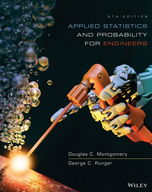Solution Found!
Astronomers treat the number of stars in a given volume of
Chapter 3, Problem 161E(choose chapter or problem)
Problem 161E
Astronomers treat the number of stars in a given volume of space as a Poisson random variable. The density in the Milky Way Galaxy in the vicinity of our solar system is one star per 16 cubic light-years.
(a) What is the probability of two or more stars in 16 cubic light-years?
(b) How many cubic light-years of space must be studied so that the probability of one or more stars exceeds 0.95?
Questions & Answers
QUESTION:
Problem 161E
Astronomers treat the number of stars in a given volume of space as a Poisson random variable. The density in the Milky Way Galaxy in the vicinity of our solar system is one star per 16 cubic light-years.
(a) What is the probability of two or more stars in 16 cubic light-years?
(b) How many cubic light-years of space must be studied so that the probability of one or more stars exceeds 0.95?
ANSWER:
Solution:
Step 1 of 3:
Let X follows the Poisson distribution with the density
P(X = x) =
Let X = number of stars per 16 cubic light years
= 1.
